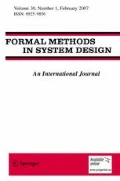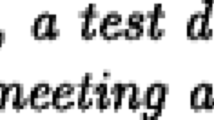Abstract
The wide adoption of semistructured data has created a growing need for effective ways to ensure the correctness of its organization. One effective way to achieve this goal is through formal specification and automated verification. This paper presents a theorem proving approach towards verifying that a particular design or organization of semistructured data is correct. We formally specify the semantics of the Object Relationship Attribute data model for Semistructured Data (ORA-SS) modeling notation and its correctness criteria for semistructured data normalization using the Prototype Verification System (PVS). The result is that effective verification on semistructured data models and their normalization can be carried out using the PVS theorem prover.
Similar content being viewed by others
References
Abiteboul S, Buneman P, Suciu D (1999) Data on the Web: from relations to semistructured data and XML. Morgan Kaufmann, San Mateo
Anutariya C, Wuwongse V, Nantajeewarawat E, Akama K (2000) Towards a foundation for XML document databases. In: EC-Web’00: proceedings of the 1st international conference on electronic commerce and Web technologies, London, UK. Springer, Berlin, pp 324–333
Arenas M, Libkin L (2004) A normal form for XML documents. ACM Trans Database Syst 29(1):195–232
Baumgartner R, Frölich O, Gottlob G, Herzog M, Lehmann P (2005) Integrating semi-structured data into business applications: a web intelligence example. In: WM’05: proceedings of the 3rd biennial conference on professional knowledge management, Kaiserslautern, Germany. Springer, Berlin, pp 469–482
Bidoit N, Cerrito S, Thion V (2004) A first step towards modeling semistructured data in hybrid multimodal logic. J Appl Non-Class Log 14(4):447–475
Bowen J, Gordon M (1995) A shallow embedding of Z in HOL. Inf Softw Technol 37(5–6):269–276
Bray T, Paoli J, Sperberg-McQueen CM, Maler E, Yergeau F (2006) Extensible markup language (XML) 1.0. http://www.w3.org/TR/2006/REC-xml-20060816/
Buneman P (1997) Semistructured data. In: PODS’97: proceedings of the 16h ACM SIGACT-SIGMOD-SIGART symposium on principles of database systems, Tucson, Arizona, USA. ACM, New York, pp 117–121
Calvanese D, De Giacomo G, Lenzerini M (1999) Representing and reasoning on XML documents: a description logic approach. J Log Comput 9(3):295–318
Chawathe SS, Garcia-Molina H, Hammer J, Ireland K, Papakonstantinou Y, Ullman JD, Widom J (1994) The TSIMMIS project: integration of heterogeneous information sources. In: IPSJ’94: proceedings of the 10th conference on information processing society of Japan, Tokyo, Japan, pp 7–18
Chen PP (1976) The entity-relationship model—toward a unified view of data. ACM Trans Database Syst 1(1):9–36
Chen YB, Ling TW, Lee M-L (2002) Designing valid XML views. In: ER’02: proceedings of the 21th international conference on conceptual modeling, Tampere, Finland. Springer, Berlin, pp 463–478
Choppella V, Sengupta A, Robertson EL, Johnson SD (2007) Preliminary explorations in specifying and validating entity-relationship models in pvs. In: AFM’07: proceedings of the second workshop on automated formal methods. ACM, New York, pp 1–10
Conforti G, Ghelli G (2003) Spatial tree logics to reason about semistructured data. In: SEBD’03: proceedings of the 11th Italian symposium on advanced database systems, Cetraro, Italy. Rubettino Editore, Soveria Mannelli, pp 37–48
Deutsch A, Fernández MF, Suciu D (1999) Storing semistructured data with STORED. In: SIGMOD’99: proceedings of ACM SIGMOD international conference on management of data, Philadelphia, Pennsylvania, USA. ACM, New York, pp 431–442
Dietrich SW, Urban SD (2004) An advanced course in database systems: beyond relational databases. Prentice Hall, New York
Dobbie G, Wu X, Ling TW, Lee ML (2001) ORA-SS: object-relationship-attribute model for semistructured data. Technical Report TR 21/00, School of Computing, National University of Singapore, Singapore
Du W, Lee M-L, Ling TW (2001) XML structures for relational data. In: WISE’01: proceedings of the 2nd international conference on web information systems engineering, Kyoto, Japan. IEEE Computer Society, Los Alamitos, pp 151–160
Elmasri R, Navathe SB (2004) Fundamentals of database systems, 4th edn. Addison-Wesley, Reading
Embley DW, Mok WY (2001) Developing XML documents with guaranteed “Good” properties. In: ER’01: proceedings of the 20th international conference on conceptual modeling, Yokohama, Japan. Springer, Berlin, pp 426–441
Harold ER, Means WS (2004) XML in a nutshell, 3rd edn. O’Reilly, Sebastopol
Hoffer JA, Prescott MB, Topi H (2008) Modern database management, 9th edn. Prentice Hall, New York,
Hunter D, Rafter J, Fawcett J, van der Vlist E, Ayers D, Duckett J, Watt A, McKinnon L (2007) Beginning XML, 4th edn. Wrox Press Ltd., Birmingham
Kifer M, Bernstein A, Lewis PM (2006) Database systems: an application-oriented approach, 2nd edn. Addison-Wesley, Reading
Lawford M, Wu H (2000) Verification of real-time control software using PVS. In: Proceedings of the 2000 conference on information sciences and systems. Princeton University Press, Princeton, pp TP1–13–TP1–17
Lee SU-J (2008) PVS definitions of ORA-SS semantics & PVS definitions of correctness criteria for semistructured data normalization. Technical Report UoA-SE-2008-3, Department of Computer Science, The University of Auckland, Auckland, New Zealand. Available at https://www.se.auckland.ac.nz/uploads/trReports/UoA-SE-2008-3.pdf
Lee SU-J, Dobbie G, Sun J, Groves L (2009) Formal verification of semistructured data models in PVS. J Univers Comput Sci 15(1):241–272
Ling TW, Lee ML, Dobbie G (2001) Applications of ORA-SS: an object-relationship-attribute data model for semistructured data. In: IIWAS’01: proceedings of the 3rd international conference on information integration and web-based applications and services, Linz, Austria, pp 17–28
Ling TW, Lee ML, Dobbie G (2005) Semistructured database design. Springer, New York
Ma Z (2005) Fuzzy database modeling with XML. The Kluwer international series on advances in database systems. Springer, New York
McHugh J, Abiteboul S, Goldman R, Quass D, Widom J (1997) Lore: a database management system for semistructured data. SIGMOD Rec 26(3):54–66
Mo Y, Ling TW (2002) Storing and maintaining semistructured data efficiently in an object-relational database. In: WISE’02: proceedings of the 3nd international conference on web information systems engineering. IEEE Computer Society, Los Alamitos, pp 247–256
Ni W, Ling TW (2005) Translate graphical XML query language to SQLX. In: DASFAA’05: proceedings of the 10th international conference on database systems for advanced applications, Beijing, China. Springer, Berlin, pp 907–913
Owre S, Shankar N (1993) Abstract datatypes in PVS. Technical Report SRI-CSL-93-9R, Computer Science Laboratory, SRI International, Menlo Park, CA, USA, December 1993. Extensively revised June 1997. Also available as NASA Contractor Report CR-97-206264
Owre S, Shankar N (1997) The formal semantics of PVS. Technical Report SRI-CSL-97-2, Computer Science Laboratory, SRI International, Menlo Park, CA, USA, August 1997
Owre S, Rushby JM, Shankar N (1992) PVS: a prototype verification system. In: CADE’92: proceedings of the 11th international conference on automated deduction, Saratoga Springs, NY, USA. Springer, Berlin, pp 748–752
Owre S, Rushby J, Shankar N, von Henke F (1995) Formal verification for fault-tolerant architectures: prolegomena to the design of PVS. IEEE Trans Softw Eng 21(2):107–125
Owre S, Rushby J, Shankar N, Stringer-Calvert D (1998) PVS: an experience report. In: FM-trends’98: proceedings of international workshop on current trends in applied formal method, Boppard, Germany. Springer, Berlin, pp 338–345
Owre S, Shankar N, Rushby JM, Stringer-Calvert DWJ (1999) PVS language reference. Computer Science Laboratory, SRI International, Menlo Park, CA,USA, September 1999
Owre S, Shankar N, Rushby JM, Stringer-Calvert DWJ (1999) PVS system guide. Computer Science Laboratory, SRI International, Menlo Park, CA,USA, September 1999
Rushby J (2000) Theorem proving for verification. In: MoVEP’00: modelling and verification of parallel processes, Nantes, France. Springer, Berlin, pp 39–57
Rushby J, Stringer-Calvert DWJ (1995) A less elementary tutorial for the PVS specification and verification system. Technical Report SRI-CSL-95-10, Computer Science Laboratory, SRI International, Menlo Park, CA, USA, June 1995
Shankar N (1993) Verification of real-time systems using PVS. In: CAV’93: proceedings of the 5th international conference on computer aided verification, Elounda, Greece. Springer, Berlin, pp 280–291
Shankar N, Owre S, Rushby JM, Stringer-Calvert DWJ (1999) PVS prover guide. Computer Science Laboratory, SRI International, Menlo Park, CA, USA, September 1999
Shih TK (2002) Distributed multimedia databases: techniques & applications. Idea Group Publishing, Hershey
Simon H (2000) XML: strategic analysis of XML for web application development. Computer Technology Research Corporation, Charleston
Srivas M, RueßH, Cyrluk D (1997) Hardware verification using PVS. In: Kropf T (ed) Formal hardware verification: methods and systems in comparison. Lecture notes in computer science, vol 1287. Springer, Berlin, pp 156–205
Sun J, Dong JS, Liu J, Wang HH (2002) A formal object approach to the design of ZML. Ann Softw Eng 13(1–4):329–356
Thuraisingham BM (2002) XML databases and the semantic web. CRC Press, Boca Raton
Vitt J, Hooman J (1996) Assertional specification and verification using PVS of the steam boiler control system. In: Formal methods for industrial applications: specifying and programming the steam boiler control. Springer, Berlin, pp 453–472
Wu X, Ling TW, Lee ML, Dobbie G (2001) Designing semistructured databases using the ORA-SS model. In: WISE’01: proceedings of the 2nd international conference on web information systems engineering, Kyoto, Japan. IEEE Computer Society, Los Alamitos, pp 171–180
Wu X, Ling TW, Lee ML, Lee SY, Dobbie G (2001) NF-SS: a normal form for semistructured schemata. In: DASWIS’01: proceedings of international workshop on data semantics in web information systems, Yokohama, Japan. Springer, Berlin, pp 292–305
Author information
Authors and Affiliations
Corresponding author
Rights and permissions
About this article
Cite this article
Lee, S.UJ., Dobbie, G., Sun, J. et al. Theorem prover approach to semistructured data design. Form Methods Syst Des 37, 1–60 (2010). https://doi.org/10.1007/s10703-010-0099-4
Published:
Issue Date:
DOI: https://doi.org/10.1007/s10703-010-0099-4




